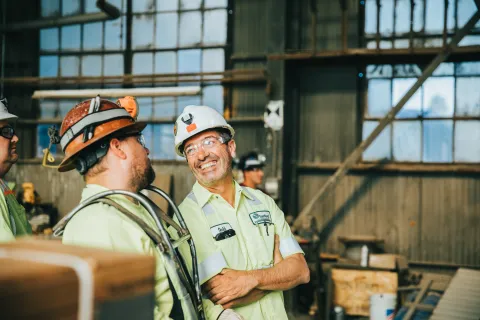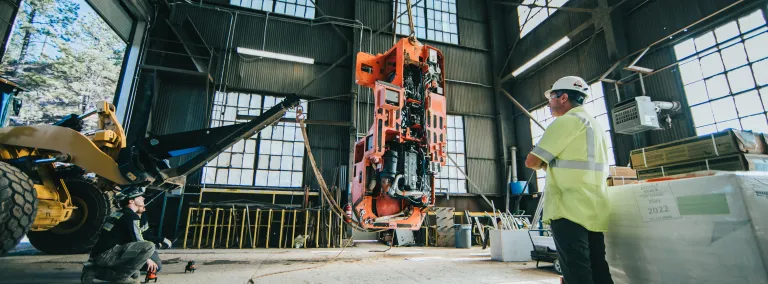Rigging underground construction
As excavation begins for DUNE, SURF and TMI plan critical lifts to rig and lower huge pieces of equipment a mile underground
The Sanford Underground Research Facility (SURF) shaft crews move equipment, materials and people underground every day inside a 13- by 5-foot cage. But what happens if something doesn’t fit in the cage? For example, how would you land a 20,000-pound, 30-foot-long raisebore drill deep underground?
Careful planning, a bit of math, practice and communication—from beginning to end.
“Our shaft is our lifeline, and we’ve got to protect our people and infrastructure,” said Wendy Straub, director of hoists and shafts. “So, communication is key.”
Often, large equipment must be taken apart and slung under the cage, then slowly lowered to the level on which it will be used. The raisebore drill was moved to the 3650 Level in May to drill a 1200-foot ventilation shaft for the Long-Baseline Neutrino Facility and Deep Underground Neutrino Experiment (LBNF/DUNE). The drill is just one of approximately 30 pieces of equipment that will need to be disassembled and transported underground for the excavation work.
Moving these pieces is a collaborative effort between SURF and Thyssen Mining Inc (TMI), the contractor executing the excavation for the DUNE project. TMI disassembled the drill into four pieces, then delivered it to the Ross cage, where SURF crews slung it under the cage—one piece at a time—and conveyed each separately underground.
“It’s our equipment so we bring it to the cage, but we don’t load it—the SURF team does that,” said Andrew Hardy, a TMI project manager working on the excavation. “They deliver it to the level where work is being done and we reassemble it there. And “SURF is fantastic to work with. We all talk the same language.”
But we’re getting ahead of ourselves.
Planning a critical lift
“We always prefer to convey everything inside the cage because there is a much lower risk,” said Will McElroy, operations division director at SURF. “So there’s a lot of planning that goes into slinging—or tethering—loads under the cage.”
The process of moving a large piece of equipment under the cage begins with a build plan. Developed by TMI, the build plan includes an engineering analysis, safety hazard analysis and a lift plan. Simultaneously, SURF develops its own critical lift plan, both of which are sent to a third-party engineering company for analysis. If no issues are found, the plan is approved, a permit is issued and a test lift is scheduled.
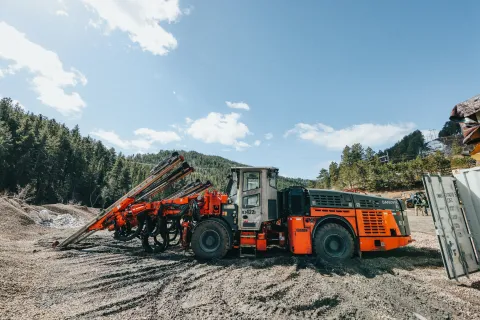
A little bit of math
Jeff Barthel is a rigging master at SURF. When developing a critical lift plan, he looks at several things.
“Before you do anything, you have to do the math,” he said. “When you are slinging a load, you’re talking about triangles, basically trigonometry, which we use to determine load angle factors and sideloading on the cage.”
He also takes into consideration the center of gravity of the object, as well as its dimensions—weight and size—and the load limits of the cage. TMI and SURF look at drawings and computer models that demonstrate how a piece of equipment will be loaded under the cage, moved down the shaft and extracted from the shaft.
“The size of the object limits what can fit in a shaft—and also be extracted from the shaft. So the first obvious consideration is the physical size and weight of the object,” Barthel said. “The other limitation is how much load we can put on the cage when feeding the object into the shaft or extracting it.”
The object being moved is placed into a specially designed sling, using pick points, or anchors to hold the object in place, then secured to pick points on the cage. The object is pulled into the shaft by the hoists, which pulls the cage toward the shaft and shaft guides, creating additional force on the cage.
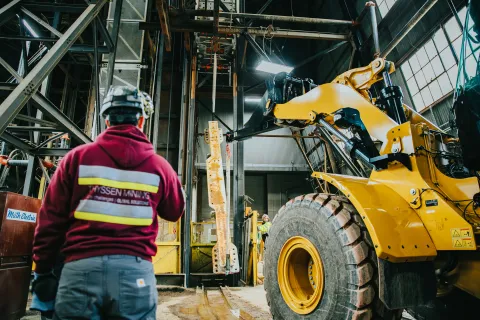
“You have to calculate all of this and support it on your lift plan. The math is key to figuring out the dynamic forces we put on the cage, the sling and the object,” Barthel said. “And you have to do it all in a safe manner so you’re not overloading the cage, you’re not overloading the guides, and you’re not overloading the slings.”
Practice makes perfect
Every slung load is different, so every plan is different. That’s why a test run, or test pick, is critical. The equipment is taken to the Ross Crusher Room where it is connected to an overhead hoist. The equipment is connected to the hoist using the same slings that will be used in the actual move then raised as if it is under the cage. As it moves, teams from TMI and SURF examine every move, looking for issues that may require adjustments to the plan.
Is the rigging (sling) the right one? Does the object hang right? How does it move as it is raised from a horizontal into a vertical position? If any concerns are raised, the plan is adjusted and sent through the review process again.
“We need to make sure everything is exactly right,” said Mike Johnson, Ross Shaft superintendent. “When we get that load underneath the cage, we have no room for error. It’s got to be perfect so we can make sure our people are safe and no damage is done.”
When everyone is satisfied, the critical lift can move forward.
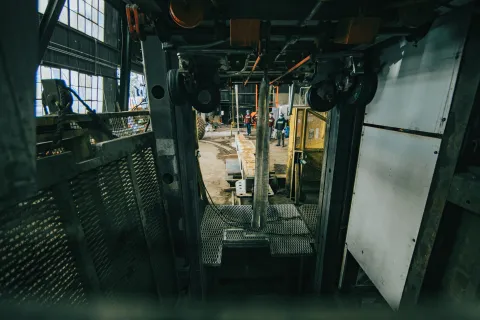
Collaboration and communication
From start to finish, collaboration and communication are critical. TMI and SURF work hand in glove to ensure everyone understands the plan and the process.
Several people take part in the lift, but at every juncture, there is one person who calls the shots. They communicate with shaft operators, the people loading and extracting the slung load, equipment operators and the hoist operator.
“The lead person is the eyes and ears for the hoist operator who is in a completely different building and can’t see anything,” Straub said. “He’s watching out for everyone’s safety.”
Loading and unloading are the most critical times of the move, Straub added. “When loading the equipment, we go from a horizontal to a vertical position. The reverse happens when unloading. All of that adds stress to the cage,” Straub said. “Once under the cage, things are fairly uneventful because the equipment is vertical.”
When the slung load is safely delivered underground, the equipment is extracted from the shaft then turned over to TMI for reassembly. Later, the two teams come together to discuss the lift and lessons learned.
“We’re always reviewing and assessing and thinking about what worked well. You look at safety, you look at efficiency, you look at what worked and didn’t work,” said Straub.
“It’s a big team effort,” Johnson said. “Everyone works so well together. One person couldn’t handle it. You need people helping and working together to make things run smooth.” After a pause, Johnson added, “It makes my job easier, you know. It takes the stress out of my mind.”
